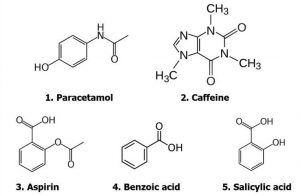Analgesic Drugs Analyzed with HPLC
A robust and rapid method was developed for the accurate simultaneous determination of Paracetamol, Aspirin, Caffeine, Benzoic Acid as an internal standard and Salicylic Acid (hydrolysis product of Aspirin). This method is rapid and sensitive and therefore suitable for routine quality control of these drugs in dosage forms and for assay methods in biological fluids.
The major challenge in HPLC has been poor Peak Shape of these small molecules and short Column life. This Method has the advantage of very good Peak shapes, excellent Sensitivity, robust and long Column Life.


Peaks:
1. Acetaminophen
2. Caffeine
3. Acetylsalicylic Acid (Aspirin)
4. Benzoic Acid (internal standard)
5. Salicylic Acid (degradation product of Aspirin)
Method Conditions
Column: Cogent Bidentate™, 4μm, 100Å
Catalog No.: 40018-75P
Dimensions: 4.6 x 75mm
Mobile Phase:
—Isocratic composition: 78:22 A / B
—A: DI Water / 0.1% Formic Acid B: Acetonitrile / 0.1% Formic Acid
Flow rate: 1.0mL / minute
Detection: UV @ 254nm
Injection vol.: 2μL
Sample Preparation: 0.02mg of Acetaminophen, Caffeine and 0.2mg of Aspirin, Benzoic Acid and Salicylic Acid were dissolved in 1mL of 50: 50 A / B Solution.
Notes: Acetaminophen (Paracetamol) is analgesic and antipyretic and with Aspirin (non-steroidal anti-inflammatory agent) they are frequently associated in pharmaceutical formulations against the common cold. Aspirin is used in prophylactic “Aspirin therapy” to reduce the risk of stroke or death in patients with myocardial infarction. The American College of Cardiology (ACC), American Heart Association (AHA), and many clinicians currently recommend low-dose “aspirin therapy”.
Attachment
No 107 Paracetamol, Aspirin and Salicylic Acid Standards HPLC Method pdf 0.2 Mb Download File


